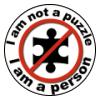DIAGNOSTIC CRITERIA FOR AUTISM DISORDER (ICD-10) (WHO 1992)
At least 8 of the 16 specified items must be fulfilled.
a. Qualitative impairments in reciprocal social interaction, as manifested by at least three of the following five:
failure adequately to use eye-to-eye gaze, facial expression, body posture and gesture to regulate social interaction.
failure to develop peer relationships.
rarely seeking and using other people for comfort and affection at times of stress or distress and/or offering comfort and affection to others when they are showing distress or unhappiness.
lack of shared enjoyment in terms of vicarious pleasure in other peoples' happiness and/or spontaneous seeking to share their own enjoyment through joint involvement with others.
lack of socio-emotional reciprocity.
b. Qualitative impairments in communication:
lack of social usage of whatever language skills are present.
impairment in make-believe and social imitative play.
poor synchrony and lack of reciprocity in conversational interchange.
poor flexibility in language expression and a relative lack of creativity and fantasy in thought processes.
lack of emotional response to other peoples' verbal and non-verbal overtures.
impaired use of variations in cadence or emphasis to reflect communicative modulation.
lack of accompanying gesture to provide emphasis or aid meaning in spoken communication.
c. Restricted, repetitive and stereotyped patterns of behavior, interests and activities, as manifested by at least two of the following six:
encompassing preoccupation with stereotyped and restricted patterns of interest.
specific attachments to unusual objects.
apparently compulsive adherence to specific, non-functional routines or rituals.
stereotyped and repetitive motor mannerisms.
preoccupations with part-objects or non-functional elements of play material.
distress over changes in small, non-functional details of the environment.
d. Developmental abnormalities must have been present in the first three years for the diagnosis to be made.








No comments:
Post a Comment